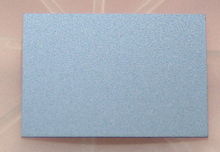Indium phosphide (InP) is a binary semiconductor composed of indium and phosphorus. It has a face-centered cubic ("zincblende") crystal structure, identical to that of GaAs and most of the III-V semiconductors.

| |

| |
| Names | |
|---|---|
| Other names
Indium(III) phosphide
| |
| Identifiers | |
3D model (JSmol)
|
|
| ChemSpider | |
| ECHA InfoCard | 100.040.856 |
PubChem CID
|
|
| UNII | |
CompTox Dashboard (EPA)
|
|
| |
| |
| Properties | |
| InP | |
| Molar mass | 145.792 g/mol |
| Appearance | black cubic crystals[1] |
| Density | 4.81 g/cm3, solid[1] |
| Melting point | 1,062 °C (1,944 °F; 1,335 K)[1] |
| Solubility | slightly soluble in acids |
| Band gap | 1.344 eV (300 K; direct) |
| Electron mobility | 5400 cm2/(V·s) (300 K) |
| Thermal conductivity | 0.68 W/(cm·K) (300 K) |
Refractive index (nD)
|
3.1 (infrared); 3.55 (632.8 nm)[2] |
| Structure | |
| Zinc blende | |
a = 5.8687 Å [3]
| |
| Tetrahedral | |
| Thermochemistry[4] | |
Heat capacity (C)
|
45.4 J/(mol·K) |
Std molar
entropy (S⦵298) |
59.8 J/(mol·K) |
Std enthalpy of
formation (ΔfH⦵298) |
-88.7 kJ/mol |
Gibbs free energy (ΔfG⦵)
|
-77.0 kJ/mol |
| Hazards | |
| Occupational safety and health (OHS/OSH): | |
Main hazards
|
Toxic, hydrolysis to phosphine |
| Safety data sheet (SDS) | External MSDS |
| Related compounds | |
Other anions
|
Indium nitride Indium arsenide Indium antimonide |
Other cations
|
Aluminium phosphide Gallium phosphide |
Related compounds
|
Indium gallium phosphide Aluminium gallium indium phosphide Gallium indium arsenide antimonide phosphide |
Except where otherwise noted, data are given for materials in their standard state (at 25 °C [77 °F], 100 kPa).
| |
Manufacturing
editIndium phosphide can be prepared from the reaction of white phosphorus and indium iodide at 400 °C.,[5] also by direct combination of the purified elements at high temperature and pressure, or by thermal decomposition of a mixture of a trialkyl indium compound and phosphine.[6]
Applications
editThe application fields of InP splits up into three main areas. It is used as the basis for optoelectronic components,[7] high-speed electronics,[8] and photovoltaics[9]
High-speed optoelectronics
editInP is used as a substrate for epitaxial optoelectronic devices based other semiconductors, such as indium gallium arsenide. The devices include pseudomorphic heterojunction bipolar transistors that could operate at 604 GHz.[10]
InP itself has a direct bandgap, making it useful for optoelectronics devices like laser diodes and photonic integrated circuits for the optical telecommunications industry, to enable wavelength-division multiplexing applications.[11] It is used in high-power and high-frequency electronics because of its superior electron velocity with respect to the more common semiconductors silicon and gallium arsenide.
Optical Communications
editInP is used in lasers, sensitive photodetectors and modulators in the wavelength window typically used for telecommunications, i.e., 1550 nm wavelengths, as it is a direct bandgap III-V compound semiconductor material. The wavelength between about 1510 nm and 1600 nm has the lowest attenuation available on optical fibre (about 0.2 dB/km).[12] Further, O-band and C-band wavelengths supported by InP facilitate single-mode operation, reducing effects of intermodal dispersion.
Photovoltaics and optical sensing
editInP can be used in photonic integrated circuits that can generate, amplify, control and detect laser light.[13]
Optical sensing applications of InP include
- Air pollution control by real-time detection of gases (CO, CO2, NOX [or NO + NO2], etc.).
- Quick verification of traces of toxic substances in gases and liquids, including tap water, or surface contaminations.
- Spectroscopy for non-destructive control of product, such as food. Researchers of Eindhoven University of Technology and MantiSpectra have already demonstrated the application of an integrated near-infrared spectral sensor for milk.[14] In addition, it has been proven that this technology can also be applied to plastics and illicit drugs.[15]
References
edit- ^ a b c Haynes, p. 4.66
- ^ Sheng Chao, Tien; Lee, Chung Len; Lei, Tan Fu (1993), "The refractive index of InP and its oxide measured by multiple-angle incident ellipsometry", Journal of Materials Science Letters, 12 (10): 721, doi:10.1007/BF00626698, S2CID 137171633.
- ^ "Basic Parameters of InP". Ioffe Institute, Russia.
- ^ Haynes, p. 5.23
- ^ Indium Phosphide at HSDB. U.S. National Institute of Health
- ^ InP manufacture. U.S. National Institute of Health
- ^ "Optoelectronic devices and components – Latest research and news | Nature". www.nature.com. Retrieved 2022-02-22.
- ^ "High Speed Electronics". www.semiconductoronline.com. Retrieved 2022-02-22.
- ^ "Photovoltaics". SEIA. Retrieved 2022-02-22.
- ^ Indium Phosphide and Indium Gallium Arsenide Help Break 600 Gigahertz Speed Barrier. Azom. April 2005
- ^ The Light Brigade appeared in Red Herring in 2002. Archived June 7, 2011, at the Wayback Machine
- ^ D’Agostino, Domenico; Carnicella, Giuseppe; Ciminelli, Caterina; Thijs, Peter; Veldhoven, Petrus J.; Ambrosius, Huub; Smit, Meint (2015-09-21). "Low-loss passive waveguides in a generic InP foundry process via local diffusion of zinc". Optics Express. 23 (19): 25143–25157. Bibcode:2015OExpr..2325143D. doi:10.1364/OE.23.025143. PMID 26406713.
- ^ Osgood, Richard Jr. (2021). Principles of photonic integrated circuits : materials, device physics, guided wave design. Xiang Meng. Springer. ISBN 978-3-030-65193-0. OCLC 1252762727.
- ^ Hakkel, Kaylee D.; Petruzzella, Maurangelo; Ou, Fang; van Klinken, Anne; Pagliano, Francesco; Liu, Tianran; van Veldhoven, Rene P. J.; Fiore, Andrea (2022-01-10). "Integrated near-infrared spectral sensing". Nature Communications. 13 (1): 103. Bibcode:2022NatCo..13..103H. doi:10.1038/s41467-021-27662-1. PMC 8748443. PMID 35013200.
- ^ Kranenburg, Ruben F.; Ou, Fang; Sevo, Petar; Petruzzella, Maurangelo; de Ridder, Renee; van Klinken, Anne; Hakkel, Kaylee D.; van Elst, Don M. J.; van Veldhoven, René; Pagliano, Francesco; van Asten, Arian C.; Fiore, Andrea (2022-08-01). "On-site illicit-drug detection with an integrated near-infrared spectral sensor: A proof of concept". Talanta. 245: 123441. doi:10.1016/j.talanta.2022.123441. PMID 35405444. S2CID 247986674.
Cited sources
edit- Haynes, William M., ed. (2016). CRC Handbook of Chemistry and Physics (97th ed.). CRC Press. ISBN 9781498754293.